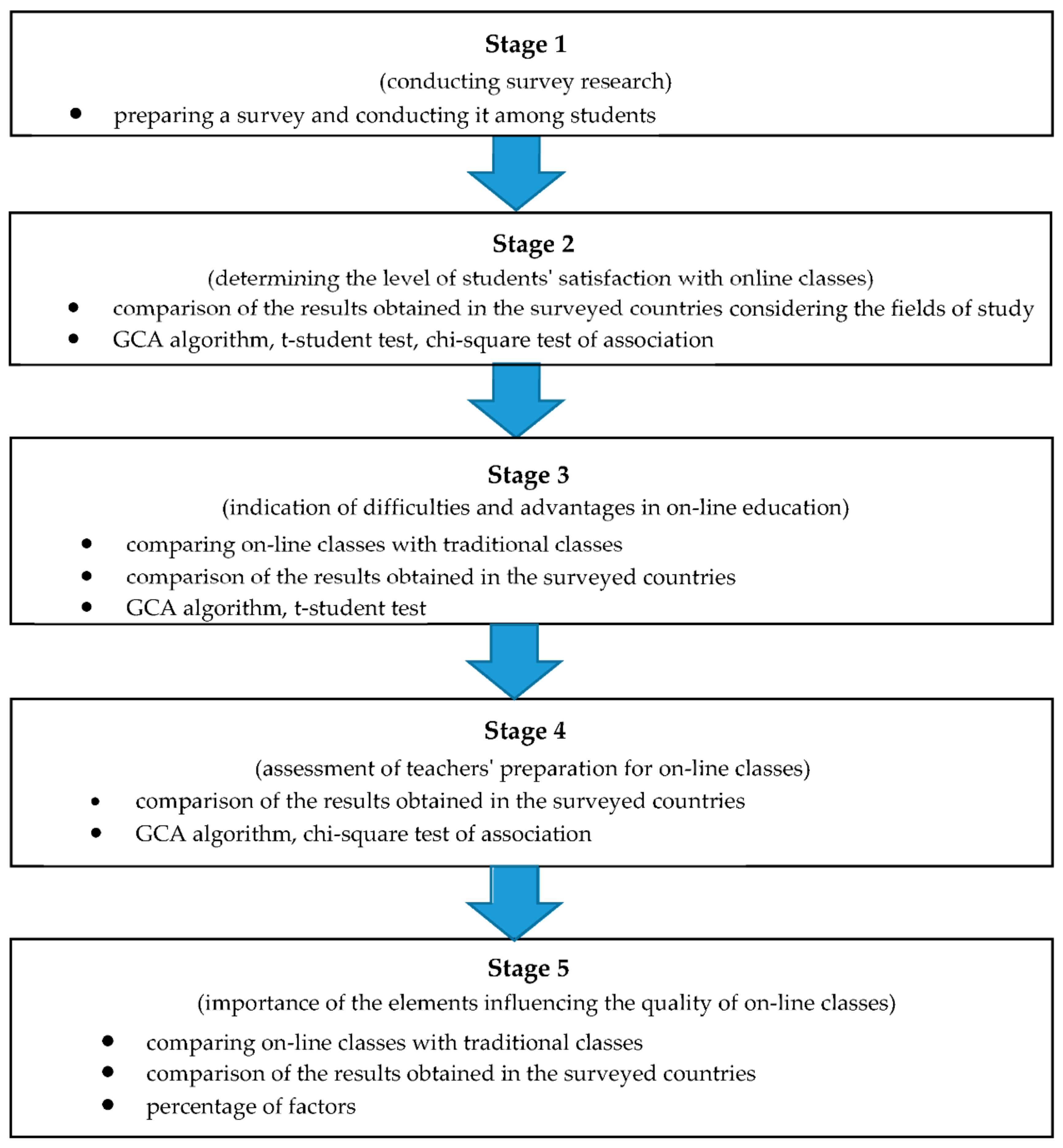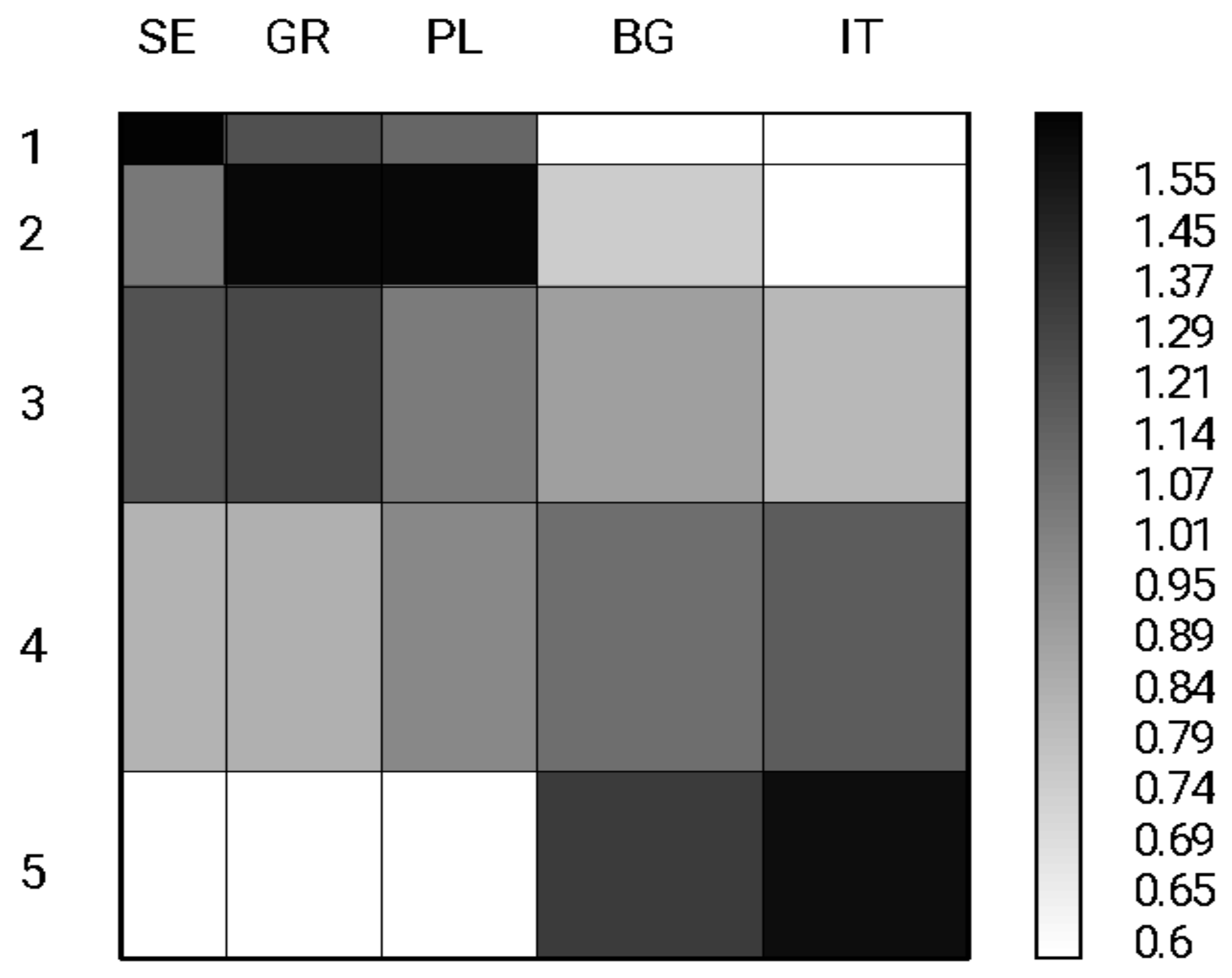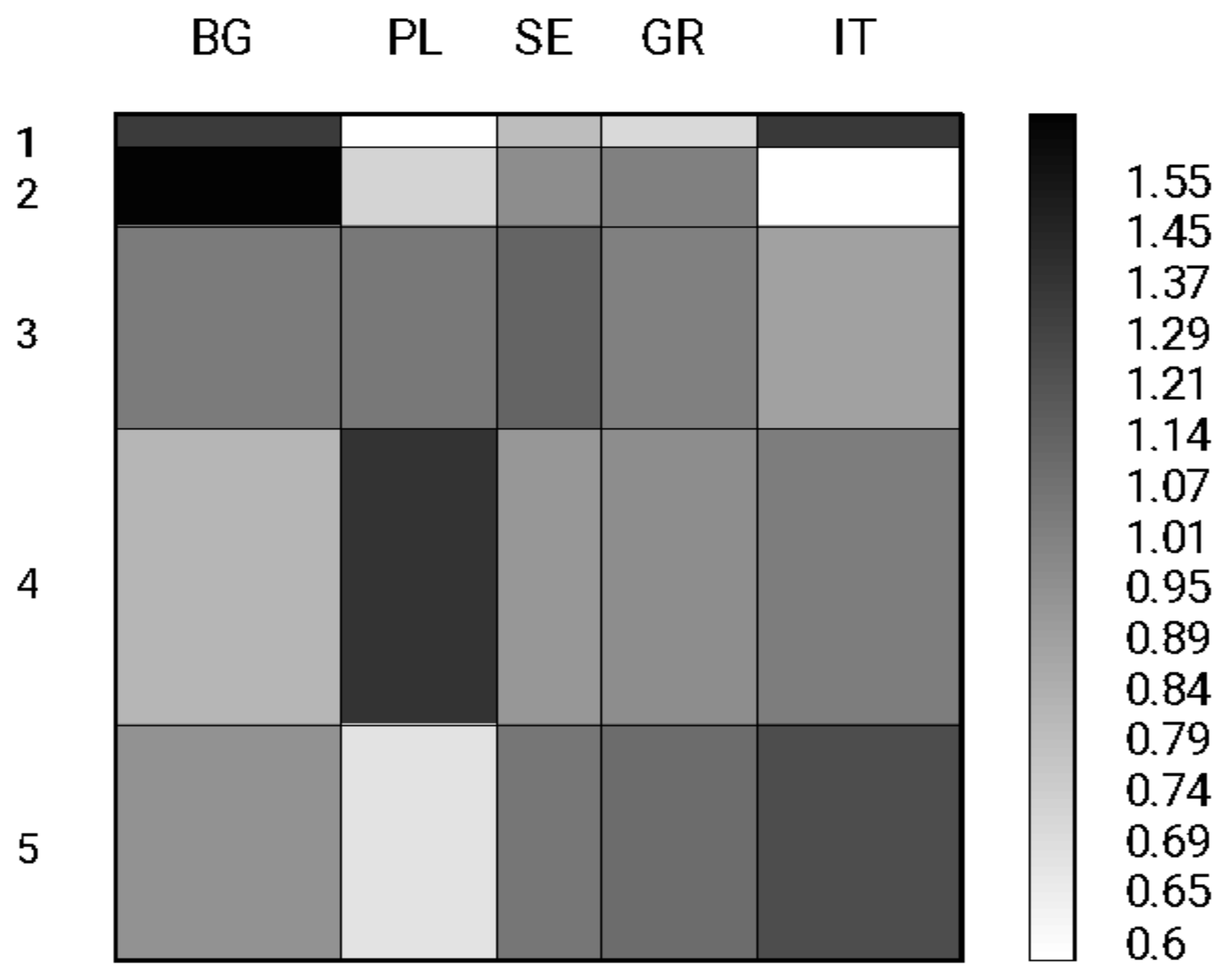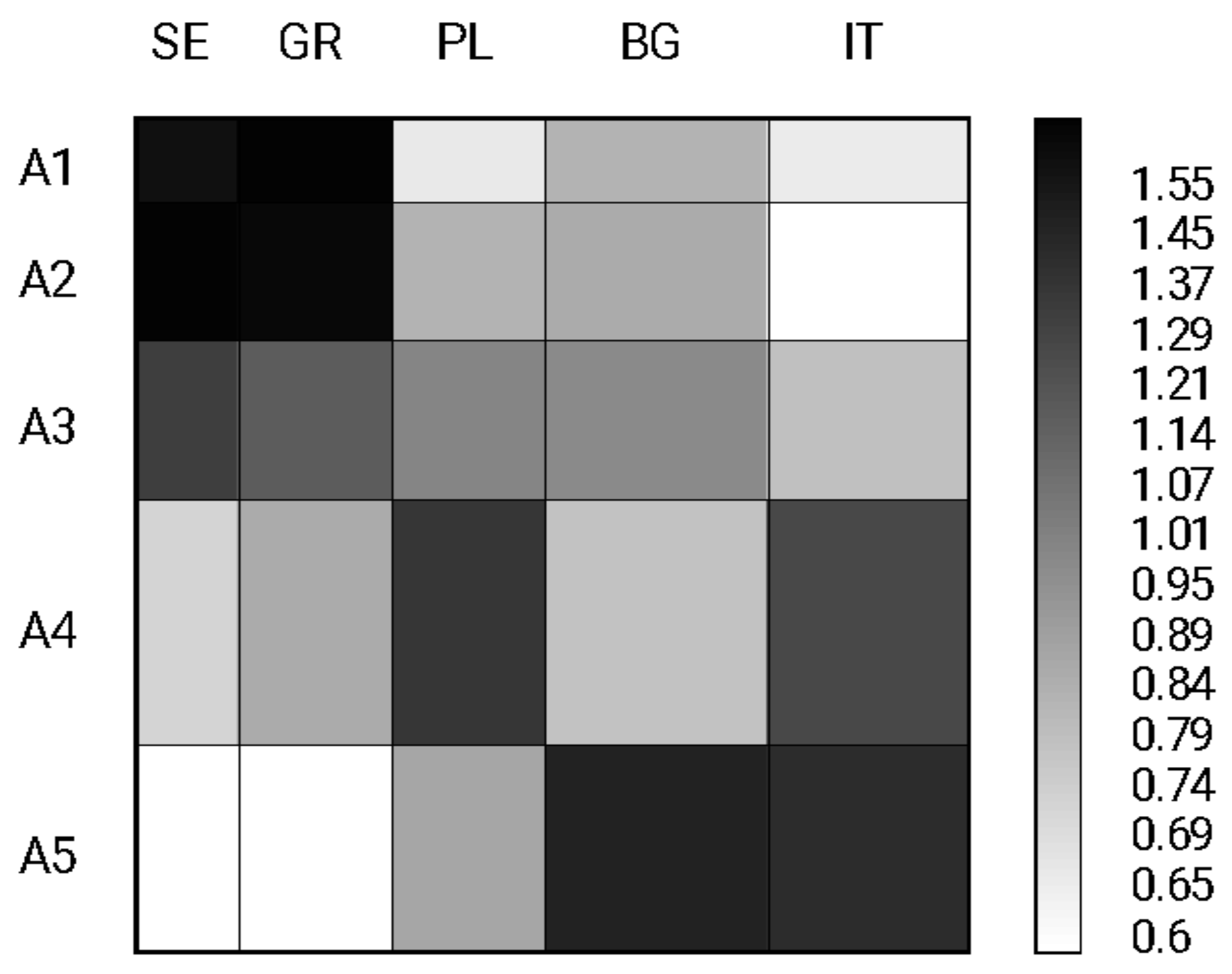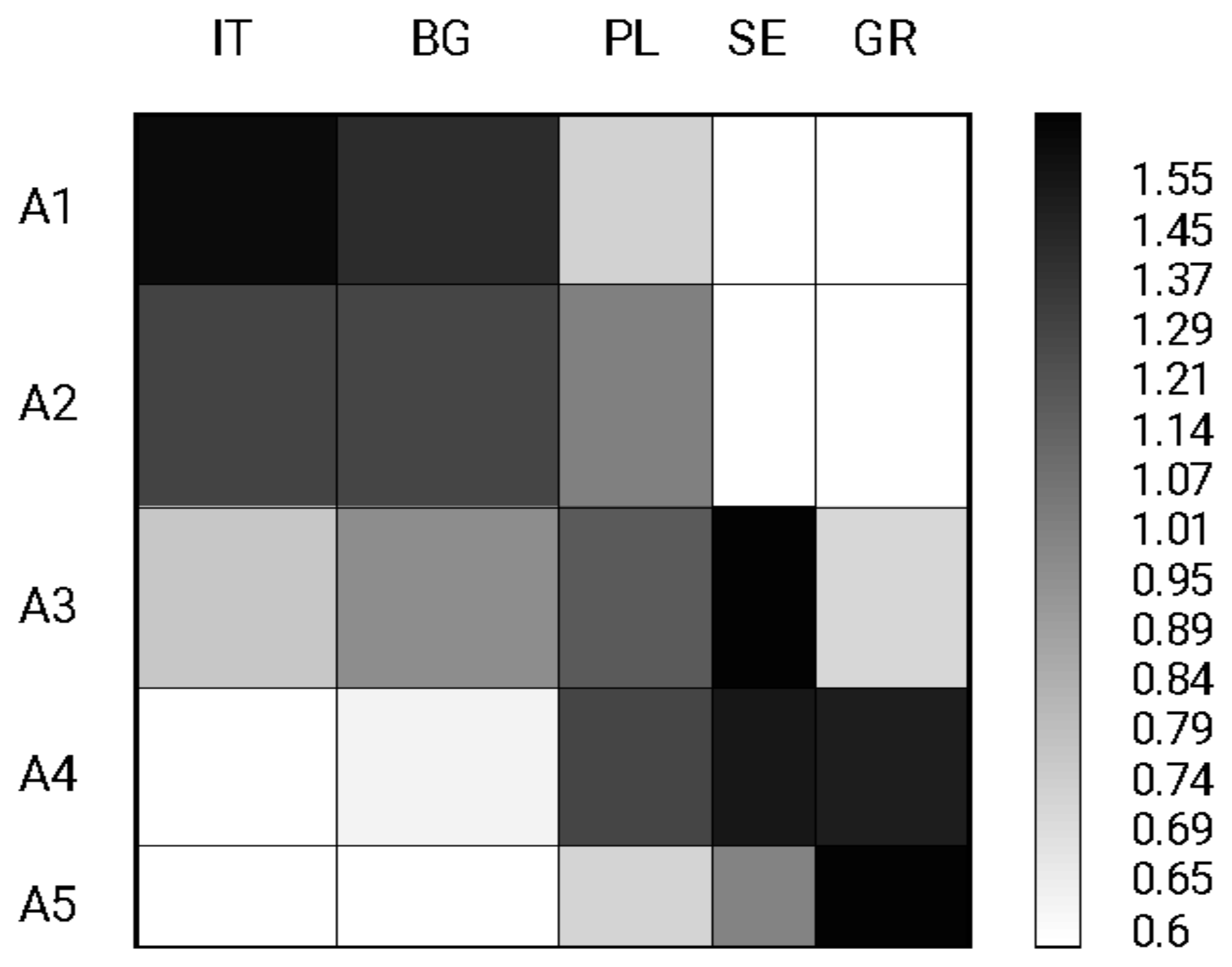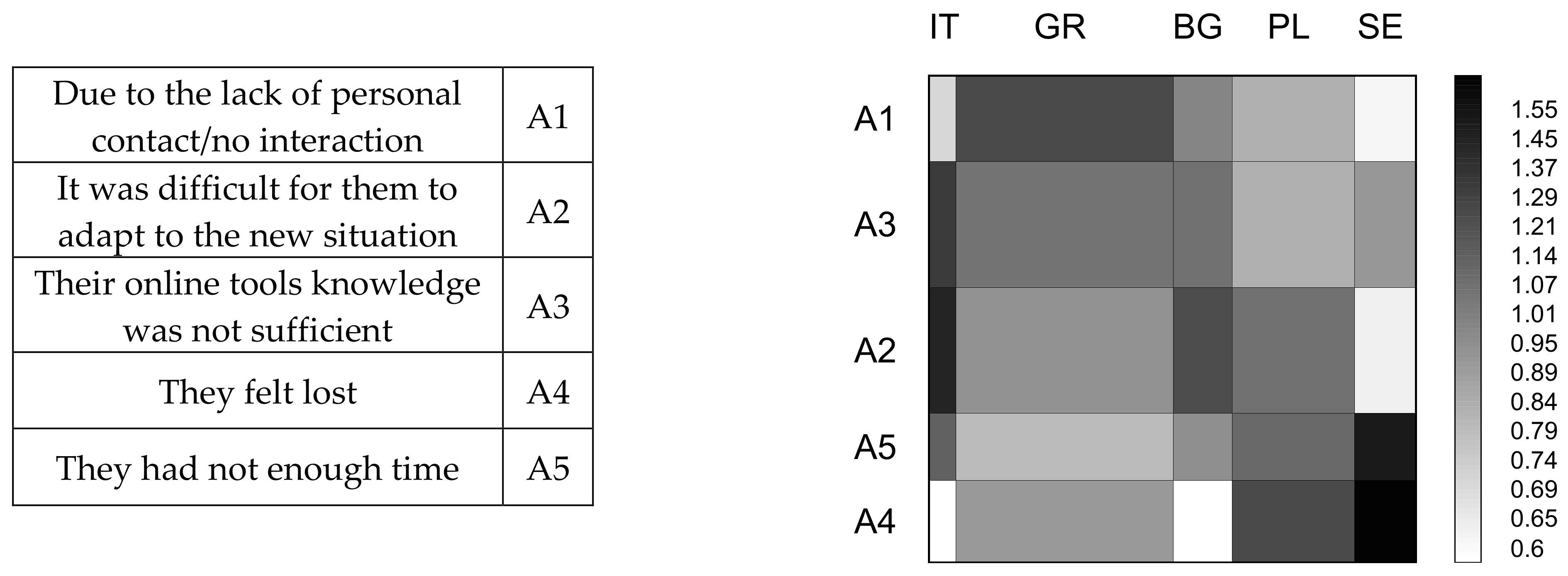2. Materials and Methods
2.1. Data Collection, Processing, and Limitations
Five EU countries, i.e., Bulgaria, Greece, Italy, Poland, Sweden, were selected for the study by means of purposive sampling. Acronyms will be used in the research results: BG (Bulgaria); GR (Greece); IT (Italy); PL (Poland); SE (Sweden). A study is based on questionnaires (
Appendix A). The surveys were carried out in autumn 2021. The questionnaire was made available to students in several educational institutions in the above-mentioned countries. Its completion was voluntary. The survey period covered the years 2020–2021. The adoption of such a period is substantively justified. In 2021, most countries coped better with the problems caused by the pandemic. The students had already used distance learning for two years, so they were able to assess this mode of knowledge transfer quite well. A certain limitation of the study is the focus on selected countries and students from a few universities. However, it is impossible to carry out research on the entire population or a very large number of students. The research carried out can be considered valuable as a result of the comparisons made in countries differing in the share of distance learning in education and experiences with it.
The questionnaire interviews were carried out as part of the co-founded by Erasmus+ Programme of the European Union project entitled “iSURVIVE-Digital Roadmap for designing online interactive content”. The project comes to help the lecturers of Higher Education institutions to transform their online courses via the use of interactive learning, gamification, and learning 2.0, which will motivate both lecturers and students to follow the online courses and further establish e-learning as a high-quality educative method and not just a forced solution. The project products will support teachers in converting their lectures to being online and will provide assistance in the form of a didactic guide with MOOC (Massive Open Online Course) training dedicated to teachers wishing to include e-learning methods to their classroom.
The questions in the questionnaire cover the following five areas (the full list of questions is available in
Appendix A):
The level of student satisfaction by the online activities;
The difficulties that students have faced when being involved in e-learning;
The most interesting and effective parts of the e-learning activities;
What students would do differently in order to increase effectiveness;
What would be more motivating for the students.
In addition to the presented sources of numerical data, the literature used was in the form of books, articles in scientific and popular science journals, reports, and articles in portals dealing with online learning.
The study is the result of the authors’ previous research on higher education. More recently, the authors’ field of interest has been the impact of COVID-19 on the situation in various sectors of the economy and aspects of society. These two areas are closely linked, as without efficient education it was not possible for higher education to function smoothly during the pandemic. In addition, the lack of up-to-date research studies on the relationship between differences in distance learning in the diverse EU countries and different subject of teaching was highlighted.
2.2. Participants
The survey was conducted among 809 student respondents representing five countries, respectively, 216 questionnaires from Bulgaria, 195 from Italy, 149 from Greece, 149 from Poland and 100 from Sweden. As the question about age was optional we do not share these results in the article. Furthermore, we do not have information about gender as it was not crucial in terms of the research and project problem.
According to student responses, the majority of them experienced both: traditional and online classes, except Italy, where 76.41% of students had only online meetings with the teacher or e-learning (
Table 1).
Most of the students surveyed (60%) do not agree with the statement that they had experience with online classes prior to the pandemic. Only, on average, less than 30% of students admitted to having experience of previous online classes. The lowest number of students to indicate that they agreed or fully agreed with the above statement was in Poland (11.41%) and Greece (20.81%). On the other hand, students from Italy had the biggest experience in online classes (as many as 54.36% indicated agree or fully agree).
The students who participated in the study represented a variety of disciplines (
Figure 1). The most common thematic area of the study was economy, management, finances and business (Bulgaria, Poland, Sweden) or social sciences, humanities and art (Italy, Greece).
2.3. Applied Methods
The research was fractionated into stages.
Figure 2 shows a scheme of the conducted research.
In the first stage, a questionnaire was prepared. Then a questionnaire survey was conducted among students. Online questionnaires were used. In the second stage of the research, the level of students’ satisfaction with online classes was determined. The obtained result was used to determine the starting position in the perception of online education in the surveyed countries. On this basis, it was possible to perform further tests and confront the obtained results with the initial assessment. Three basic methods were used, such as GCA (Grade Correspondence Analysis), Student’s t-test for two populations for inequality of means and Chi-square test of association. Those methods are described more detailed at the end of this section.
The third stage of the research presented the difficulties and advantages for distance learning in each country. For this purpose, a comparison was made between online classes and traditional classes. As a result, regularities were obtained and the advantages or disadvantages of remote learning in relation to on-site learning were determined. In addition, the results were contrasted in several countries. Again, the GCA (Grade Correspondence Analysis) method and the Student’s t-test for two populations for non-equality of means were used.
The fourth stage of the research concerned the evaluation of teachers’ preparation for online classes. Here, the results differed among the countries and fields of study, which was contrasted with previous evaluations of classroom satisfaction. The GCA method was used.
The fifth stage was concerned with gathering students’ opinions on the elements that influence the quality of online classes compared to face-to-face classes. The percentage results on the importance of each factor were presented.
GCA was the sum of the multivariate data analysis techniques, which can be used to graphically show the dynamics of phenomena or polarities between objects in the shape of overrepresentation maps. The so-called overrepresentation maps, which illustrate each underrepresentation and overrepresentation of compositions describing a given subject by contrasting them with average results of these compositions, are of special significance. The GCA algorithm (called grid-based clustering algorithm) also permits the creation of groups, but it makes them in a way which allows the generation of objects that are specified by the greatest possible polarity among themselves. The clusters are formed as an effect of combining objects, which ensure such polarization, and for this objective, some of the independence index, Ro or Tau, is being optimized. Overrepresentation is the relation of the component compositions to the average quantity. As an average, we mean the ratio of the sum of the values. After determining the average quantities, we can count the so-called “overrepresentation indicators”. This indicator shows how far the observed quantity disagrees from that which would be awaited given the ideal proportion of the distribution. For a perfect representation, the index will take the value one. The determined overrepresentation coefficients permit illustration the “map of overrepresentation”. With appropriate quantities of the indexes, different shades of grey are coded (the overrepresentation map for the ratable distribution would be evenly grey without any shades). This map is a square with flankes equal to one. In this case, the rows are types of the answer, on the other hand the columns are countries. Colors present overrepresentation (extreme black) and underrepresentation (extreme white). This map has rows and columns to diversify heights and widths:
- -
height is specified by the percentage share of particular answer variant in all answers;
- -
width of the columns is the number of answers in a particular country.
The main question in GDA is studying the heterogeneity of rows and columns and the aspiration to organize them in the data matrix to achieve the maximum difference among the outermost rows and columns. The goal is made by the GCA (called Grade Correspondence Analysis) algorithm. This algorithm changes the columns and rows of the data matrix to optimize a certain dependency coefficient. Only the columns are changed as the rows are in an unchanged order. This dependency indicator is the Kendall’s tau or rho-Spearman correlation coefficient and relies especially on the dissimilarity index “ar”. Basing on these indexes, clusters are made to maximize the difference between them.
We used grade data analysis to see multidimensional differences, such as different groups from different countries on one graph to visualize the differences.
These groups are formed as an effect of joining objects that guarantee such differences, and for this aim a certain independence indicator, Ro or Tau, is optimized [
62].
In the literature are many proposals for the building of structure dissimilarity indexes. Distances are frequently used for this goal, e.g., Minkowski metric [
63].
If we have two configuration:
x and
y, where:
this measure for sure meets two cases:
The distance betwixt objects with the similarly structure is equivalent to “0”, so: d(x, x) = 0
The length betwixt the Y object and the X object is the similarly as between X and Y and it is not smaller than “0”, that is: d(x, y) ≥ 0
One can have little doubt as to the correctness of the execution of the third requirement by the dissimilarity indicator:
- 3.
The length measure changes appropriately to the “transfer sensitivity” accepted in the concentration indexes, where the increase in the quantity of the dissimilarity indicator at a fixed transfer quantity is larger the “richer” object is that was transferred.
The structure of the dissimilarity indicator of structures meeting the requirement 3 can then depend on the concentration indicator (Gini coefficient) and the Lorentz curve [
64].
In the case of the Lorentz curve, the difference of the Y structure to the X construction can be shown as a broken line connecting some points, which in this case, have the coordinates next to the cumulative structures, and the size of the difference of the Y structure to the X construction is, also by analogy—now with the Gini coefficient—is the size “ar”.
where:
belongs to the cluster of continuous functions.
Visualization of the structures was conducted with the utilization of overrepresentation maps. Overrepresentation is the ratio of the component construction to the average quantity. The algorithm changes the columns and rows of the data matrix to maximize some of the dependency ratio.
The second method of testing is the Student’s
t-test for two populations. With these tests we verify the hypothesis of equality of average values in the two populations, i.e., we hypothesize [
65]:
against one of the alternative hypotheses:
Depending on the type and abundance of data we have, we choose the appropriate type of test—for unrelated variables or for related variables.
We assume normality of the distributions and homogeneity of the variances within the groups. To determine the test statistic, we first determine the following: the mean value among the subjects, the size of the two groups, the variance in the tested groups:
The third method utilized for calculation is chi-square test of independence (called chi-square test of association), to identify whether two categorical variables are connected. The chi-square test of independence calculation focusses on the observed frequencies, which are the numbers of perceptions in each combined cluster. Null hypothesis is verified: variable 1 and variable 2 are not connected in the population, contrary to the optional hypothesis that variable 1 and variable 2 are connected in the population (the ratio of variable 1 are not identical and there are different quantities of variable 2). Test statistics were calculated according to the following formula [
66]:
where:
O is the observed frequency and
E is the expected frequency.
One would reject the null hypothesis, if the calculated test statistic is higher than the critical value based on the degrees of freedom and α level.
Descriptive, graphic and tabular methods were also used to show some of the findings.
4. Discussion
E-learning in many Universities around the world was not much developed and popular before the pandemic. According to Pham and Ho [
67], in Vietnam in 2016, only 2% of university students were involved in remote learning. According to Ruiz-Alonso-Bartol et al. [
68], in the same year in the US, 31.6% of students had taken at least one online course. According to Hebert et al. [
69], the problem affected not only students but also lecturers. Based on a study in four public regional universities in the southern USA, it was found that only 43% had taught online courses before the pandemic. In our study, we obtained similar results with regard to students’ university origin. In most countries, there was a small percent of students who had previously had online classes. The exception was Italy, with a very high proportion of such students. The proportion of students and teachers who had previously taken online classes may be related to a country’s level of development, but also to a number of other factors, such as society’s readiness for change.
Even before the pandemic, there was quite a lot of research on student satisfaction with online classes. For example, Blake [
70], Levy et al. [
71] and Stickler and Hampel [
72] pointed out the importance of the lecturer’s commitment and positive attitude. The effectiveness of a new technology and online course depends largely on the skills of the lecturer and their ability to create a comfortable learning environment. Sarwar et al. [
73], based on a study on dental students in Pakistan, found that first-year students in particular were not satisfied with this method of learning, which may be due to poor interaction with teachers. Ali et al. [
74] also stated in his study in Pakistan that students rated online learning as unproductive. According to Pastor [
75], dissatisfaction was also reported by the majority of students in the Philippines, with connectivity problems being the main reason. Thus, these were technological barriers. In economically developed countries, such problems should be limited. Baber [
76], based on a study of students in South Korea and India, found that the following factors had a positive impact on student satisfaction: student motivation; classroom interaction; instructor knowledge and facilitation; course structure. These results were the same in both countries. Similar relationships were pointed out by Xu et al. [
77] using China as an example. In our study, we obtained inconclusive results. The highest satisfaction was in Italy. In a study by Rossettini et al. [
78], students’ satisfaction with online learning was also confirmed to be high and, interestingly, it was higher than in the case of face-to-face classes. In a study by Szopinski and Bachnik [
79], differences in student satisfaction depending on nationality were confirmed. Students from Poland, Ukraine and Belarus were studied. The level of satisfaction was higher among Polish students. In Angelov’s [
80] study of Bulgaria, it was found that students rated online classes as much as traditional lectures in auditoriums. In our study, the ratings of Bulgarian students were also very high. Giannoulas et al. [
81] conducted a study among Greek students. They found a low evaluation of student satisfaction with online classes, which was mainly due to technical problems. Interestingly, despite the negative ratings, students were interested in remote learning in the future. In our study, Greek students were the least happy with remote learning. Warfvinge et al. [
82] found low satisfaction with remote learning among Swedish students. Above all, less feedback from lecturers was a problem. In our study, Swedish students also showed low evaluation rate of online learning.
Ghasem and Ghannam [
83], based on a study in the United Arab Emirates, found that students in online classes reported difficulty in concentrating during online lessons with limited student–instructor interactions. In general, there is no unanimity across countries regarding satisfaction with classes. For example, Tuaycharoen [
84], based on a study of Thai students, found very high levels of satisfaction with online classes with a mean score of 4.54 on a 5-point Likert Scale. In our study in Italy, we obtained a score of 4.34. Shalatska et al. [
85] found that, for a good evaluation, students depended on a personalized approach to the learning process, easily accessible and quick feedback and interactive methods. Qi and Liu [
86], based on massive open online courses (MOOCs), identified the criteria that are most important in evaluating online courses. These were instructor, course content, course evaluation, online platform, and course timeliness. Again, attention is drawn to the aspect related to the lecturer and their key role. Agyeiwaah et al. [
87] in their study highlighted the attributes of remote learning. These were: transparency and reliability; stimulation and appeal; and usability and innovation. Khan et al. [
88] found that ICT knowledge was one of the most important factors affecting the quality of online classes. In our study, students also indicated this problem.
According to Puljak et al. [
89], although students were mostly adaptable to e-learning, they felt that e-learning could not replace traditional classes. Stanistreet et al. [
90] claim that there was little readiness to suddenly switch to remote education on both sides—students and lecturers. Rony and Awal [
91] pointed out the lack of instruction for lecturers in the early stages of the pandemic. Ramos-Pla et al. [
92] found that difficulties were the lack of time to adapt teaching practice to the knowledge gained, as well as the complexity of conducting online evaluations. In our study, students also highlighted those aspects on the side of the lecturers. It can be concluded that each side saw problems and had concerns. Once again, the importance of human interactions that may have been responsible for the perception and evaluation of distance learning needs to be emphasized. Such relationships have been highlighted in many studies, such as Cidral et al. [
93], Joo et al. [
94]. Schleicher [
95] states that in online learning more autonomy, self-regulation and remote learning skills are required from students in order to learn effectively. Keržič et al. [
96] did one of the few comprehensive studies on online learning. They examined students’ evaluation of online learning in a sample of 10,092 university students from 10 countries on four continents during the first pandemic wave. They found that the main determinants of e-learning advantage were service quality and overall system quality. Less, but still important, were online interactions with other students and teachers and students’ computer skills. The results confirm previous findings. Students see a large role of the system and the way lecturers provide services for a high evaluation of the quality of education. In our study, we found similar results, with students additionally noting the flexibility of distance learning. Aristovnik et al. [
97], based on the same database as Keržič et al. [
96], presented results from a sample of 31,212 students from 133 countries. The data were collected as part of CovidSocLab [
98]. More than 1,000 responses were collected in 10 countries (Poland, Mexico, Turkey, Italy, India, Chile, Ecuador, Portugal, Bangladesh, Slovenia); between 500 and 1000 responses in seven countries (Romania, Pakistan, Croatia, Indonesia, Hungary, Brazil, Ghana); between 200 and 500 answers were collected in 19 nations; a total of 2911 answers were collected in 41 nations with between 10 and 200 answers; and a total of 130 answers were collected in 56 nations with less than 10 answers. In particular, responses from the former group may influence the final result. Poland and Italy were in this group. Student satisfaction with videoconferencing was rated positively by 54.9% of respondents, with recorded videos by 43.6%. Aspects related to the timely response of the teaching staff were rated positively by 46.1% of respondents, and the support of the teaching staff by 48.4%. In our study, apart from Italy, we also obtained quite low scores for the evaluation of online classes. The aspects given were also identified as being key to improving the quality of online teaching. Crawford et al. [
99], based on a study in 20 countries, found that the adaptation of universities to the pandemic situation varied, from social isolation tactics on campus to rapid remodelling of curricula to achieve fully online learning. In the European Commission survey, the majority of universities agreed that they had a scheme to increase digital ability (75%) and explore new methods of teaching (92%) outside the crisis [
100]. This is why digital and online education does not appear mainly as a contingency experiment during COVID-19. The pandemic has produced a new group of students who were previously not fully interested in online learning [
101]. Therefore, universities are interested in expanding their online programs may also initiate additional online courses. Adequate IT support and teacher training must be provided to ensure quality online education. New specialists such as course designers, multimedia specialists and support staff, production specialists may need to be recruited. Their task will be to design and create online materials and provide support [
102].

